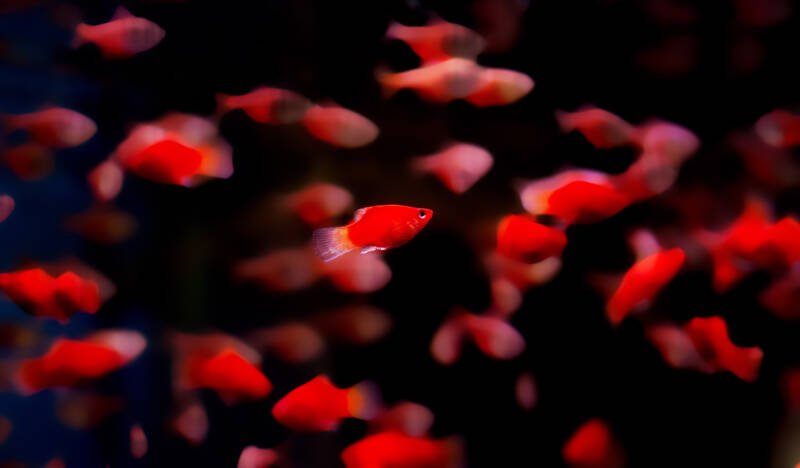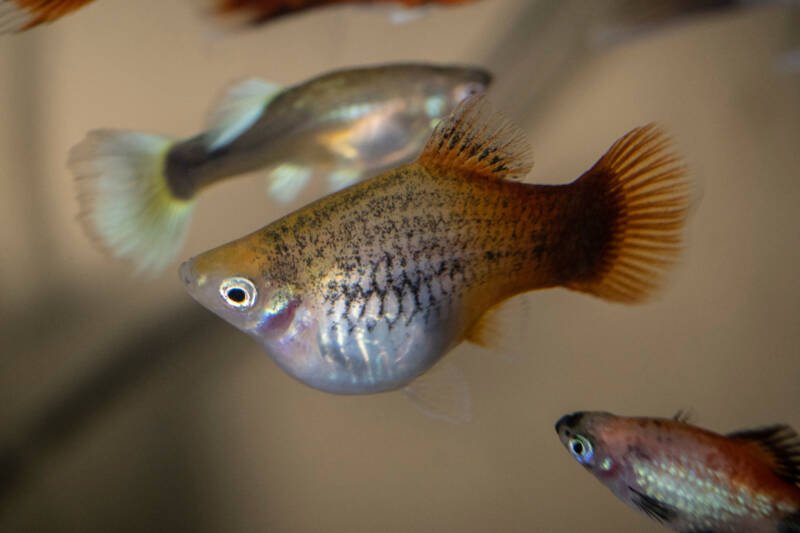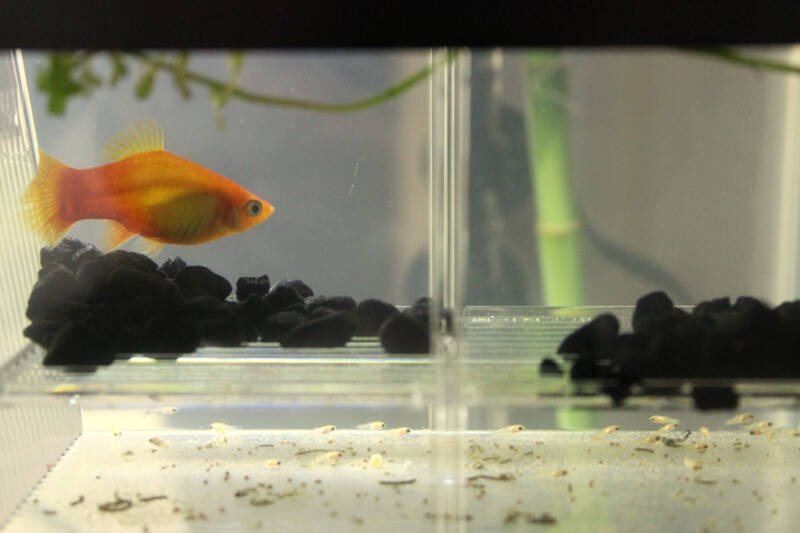The platy is a hardy, warm water fish from Central America that comes in several color variations.

It is popular in the aquarium trade due to its active nature and peaceful temperament. One thing platy owners will soon see is that these fish are also prolific breeders that will readily and regularly reproduce in a community tank.
While these fish and their offspring are easy to care for, there are a few things to remember to ensure a successful birth.

Keep reading for more on platy pregnancy. This information is useful if you are interested in breeding your platy fish or if you simply plan on keeping males and females together in the same tank.
In this article
Platy Biology

Platy fish can breed once they are four months old (although they are not considered “adult” fish until six months of age).
This species is a livebearer, which means that the female gives birth to free-swimming young.
The term of gestation is 28 days. When paired with a male in a community tank, this means your female platy can potentially give birth every four weeks.
Differences between Male and Female Platy
You may wish to first determine which of your fish are male and female. Fortunately, there are some aspects of sexual dimorphism with this species.
The female tends to be larger in size overall and has a wider, fan-shaped anal fin.

Males have a pointed anal fin called a gonopodium, which they use to inseminate the female.

How to Tell if Your Platy is Pregnant
There are physical and behavioral indicators that your female platy may be pregnant.
Physical Changes
As the young develop in her body, your female’s abdomen will begin to swell. When she is close to giving birth, her abdomen may even take on a “square” shape, and her cloaca may become dilated.

Look for the presence of a gravid spot, which is a dark spot on the female’s abdomen near the anal fin. This spot, which will enlarge and grow darker, indicates that fry are developing.
Your female’s entire body may darken as well.
Behavioral Changes
Once the female is pregnant, she might shadow her mate around the tank. As she nears the time to bear her young, this activity may reverse, with the male chasing her excessively.
Too much chasing could stress the female and delay or prevent the birth.
Your female may also hide in a secure part of the tank away from other fish. This could indicate that she is looking to feel safe and have a spot to deliver her young.
If you notice these behaviors, remove the female from the community tank and place her in the breeding tank.
Set Up a Breeding Tank

Adult platy fish are small (1.5 to 2.5 inches, 4 to 6 cm) and do not require a large tank, but remember that the young will be born live and will need a separate tank with space to grow.
A 10- to-20-gallon tank is sufficient for a breeding tank.
Add live plants, such as duckweed, hornwort, or java moss. These plants will provide shelter for your female to feel secure as she gives birth, hiding places for the newly born fry, and oxygen to the water.
Water Parameters
In the wild, platy fish are found in warm, still waters with silt beds and heavy vegetation. Your breeding tank should mimic this environment.
Keep the water temperature between 70 and 77 degrees Fahrenheit (21 to 25 degrees C).
The water hardness should be between 10 to 28 dGH and the pH range between 6.8 and 8.0. Change 25 percent of the water every two weeks to maintain cleanliness.
Equipment
Installing a heater can help to keep the temperatures consistently in an acceptable range. If your tank is not heavily planted, consider adding an air stone to keep up the oxygen levels in the water.
It is also a good idea to invest in some testing kits and test the water regularly to ensure the ammonia and nitrite levels are acceptable.
One option to protect the newly born fry is to place the female inside a breeding box. This box slips inside the breeding tank and has small holes that the babies can pass through.
Another option is to use a mesh net breeder to separate the fry from the mother.
Feeding Your Pregnant Platy
Your pregnant platy will not need any special foods, although you may see that she needs an increased amount and becomes more aggressive when feeding.
Treat her with some high protein foods, such as brine shrimp or bloodworms.
Birthing
Watch your female for signs of the upcoming birth, which will typically occur at night.
The fry are born one at a time, tail first. While a normal batch is from eight to 20, your female can give birth to as many as 40 fry.
The entire process lasts a few hours, but do not be surprised if it goes on for a longer span of time. Your female can give birth to additional fish over the next few days or weeks.
Once the birthing process is complete, remove the mother from the tank. Adult platy fish show no parental instincts and are known to eat the fry if given the opportunity.
Baby Platy Care and Feeding

Newly born platy fry are difficult to see. They will be from 7 to 8 mm in length and almost clear in color.
They also tend to hide in the foliage or the tank’s tiniest spaces. However, within the next two to four months, they will grow, and their color should begin to emerge.
At first, feed the babies liquid fry food or crushed commercial flakes. Look for food that is formulated for live-bearing fish.
After that, feel free to give them baby brine shrimp, daphnia, or microworms. They will also enjoy a treat of steamed or blanched vegetables every now and then. Zucchini, broccoli, or peas are excellent choices.
Remove any uneaten food to avoid decaying food impacting your water quality.
Feed small amounts frequently during the day. Make sure that the food you provide is small enough for them to consume.
Keep the fry separated from the adults in the community tank for at least two weeks or until they have grown large enough that the adults cannot eat them.
Frequently Asked Questions
The following are some frequently asked questions regarding pregnant platy fish.
How can you tell a platy is pregnant?
The best ways to determine whether your female platy is pregnant are physical changes.
First, the female’s abdomen will become rounded with her developing young. Her overall color may darken, and you may see an enlargement and darkening of her gravid spot.
Do platy fish lay eggs?
No. Platy fish are a live-bearing species, so the young are born free swimming.
How many babies do platies have?
Platy fish females typically birth from eight to twenty young, although they can have up to forty.
Should I separate my pregnant platy?
It is a good idea to separate your pregnant female if you want to give the fry their best chance at survival.
Separating the female also allows her to give birth without the stress of other fish in the tank.
Why do male platies chase pregnant females?
Your male could be chasing your female because she is close to giving birth. If that is the case, you may want to remove her to a breeding tank so that she does not become so stressed that she loses the babies.
How long do platies stay pregnant?
Platy gestation time is around 28 days.
Do platies eat their babies?
They can if given the opportunity. The babies are almost transparent and have a knack for hiding, which gives them an advantage.
However, opportunistic adult platy fish will indeed see them as a food source. It is best to keep the fry separate until they are larger than the mouths of the adult fish.
Closing Thoughts
With their ease and frequency of breeding, the platy is an excellent choice for a beginner looking to breed fish.
The fry themselves are easy to care for and hardy. There are very few requirements other than a well set up breeding tank to ensure a successful birth and the survival of the offspring.
Drop us a message below and let us know your experiences with breeding your platies.
What is your ideal breeding tank setup?